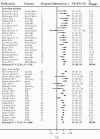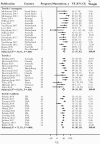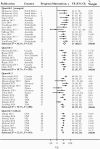Decline in Seasonal Influenza Vaccine Effectiveness With Vaccination Program Maturation: A Systematic Review and Meta-analysis
- PMID: 33738320
- PMCID: PMC7953658
- DOI: 10.1093/ofid/ofab069
Decline in Seasonal Influenza Vaccine Effectiveness With Vaccination Program Maturation: A Systematic Review and Meta-analysis
Abstract
Background: Evidence suggests that repeated influenza vaccination may reduce vaccine effectiveness (VE). Using influenza vaccination program maturation (PM; number of years since program inception) as a proxy for population-level repeated vaccination, we assessed the impact on pooled adjusted end-season VE estimates from outpatient test-negative design studies.
Methods: We systematically searched and selected full-text publications from January 2011 to February 2020 (PROSPERO: CRD42017064595). We obtained influenza vaccination program inception year for each country and calculated PM as the difference between the year of deployment and year of program inception. We categorized PM into halves (cut at the median), tertiles, and quartiles and calculated pooled VE using an inverse-variance random-effects model. The primary outcome was pooled VE against all influenza.
Results: We included 72 articles from 11 931 citations. Across the 3 categorizations of PM, a lower pooled VE against all influenza for all patients was observed with PM. Substantially higher reductions were observed in older adults (≥65 years). We observed similar results for A(H1N1)pdm09, A(H3N2), and influenza B.
Conclusions: The evidence suggests that influenza VE declines with vaccination PM. This study forms the basis for further discussions and examinations of the potential impact of vaccination PM on seasonal VE.
Keywords: seasonal influenza; systematic review; test-negative design; vaccination program; vaccine effectiveness.
© The Author(s) 2021. Published by Oxford University Press on behalf of Infectious Diseases Society of America.
Figures




Similar articles
-
The European I-MOVE Multicentre 2013-2014 Case-Control Study. Homogeneous moderate influenza vaccine effectiveness against A(H1N1)pdm09 and heterogenous results by country against A(H3N2).Vaccine. 2015 Jun 4;33(24):2813-22. doi: 10.1016/j.vaccine.2015.04.012. Epub 2015 Apr 28. Vaccine. 2015. PMID: 25936723
-
Variations in Seasonal Influenza Vaccine Effectiveness due to Study Characteristics: A Systematic Review and Meta-analysis of Test-Negative Design Studies.Open Forum Infect Dis. 2020 May 21;7(7):ofaa177. doi: 10.1093/ofid/ofaa177. eCollection 2020 Jul. Open Forum Infect Dis. 2020. PMID: 32704509 Free PMC article. Review.
-
Beyond Antigenic Match: Possible Agent-Host and Immuno-epidemiological Influences on Influenza Vaccine Effectiveness During the 2015-2016 Season in Canada.J Infect Dis. 2017 Dec 19;216(12):1487-1500. doi: 10.1093/infdis/jix526. J Infect Dis. 2017. PMID: 29029166 Free PMC article.
-
Association of Prior Vaccination With Influenza Vaccine Effectiveness in Children Receiving Live Attenuated or Inactivated Vaccine.JAMA Netw Open. 2018 Oct 5;1(6):e183742. doi: 10.1001/jamanetworkopen.2018.3742. JAMA Netw Open. 2018. PMID: 30646262 Free PMC article.
-
Duration of Influenza Vaccine Effectiveness: A Systematic Review, Meta-analysis, and Meta-regression of Test-Negative Design Case-Control Studies.J Infect Dis. 2018 Feb 14;217(5):731-741. doi: 10.1093/infdis/jix632. J Infect Dis. 2018. PMID: 29220496
Cited by
-
Influenza B Virus (IBV) Immune-Mediated Disease in C57BL/6 Mice.Vaccines (Basel). 2022 Sep 1;10(9):1440. doi: 10.3390/vaccines10091440. Vaccines (Basel). 2022. PMID: 36146518 Free PMC article.
-
Impact of sex on humoral immunity with live influenza B virus vaccines in mice.NPJ Vaccines. 2024 Feb 26;9(1):45. doi: 10.1038/s41541-024-00827-x. NPJ Vaccines. 2024. PMID: 38409236 Free PMC article.
-
Influenza Vaccine Effectiveness: Analysis of the Impact of Repeated Vaccinations in Military Health System Beneficiaries.Open Forum Infect Dis. 2022 Sep 29;9(10):ofac497. doi: 10.1093/ofid/ofac497. eCollection 2022 Oct. Open Forum Infect Dis. 2022. PMID: 36275868 Free PMC article.
-
Estimating population-based incidence of community-acquired pneumonia and acute otitis media in children and adults in Ontario and British Columbia using health administrative data, 2005-2018: a Canadian Immunisation Research Network (CIRN) study.BMJ Open Respir Res. 2022 Jun;9(1):e001218. doi: 10.1136/bmjresp-2022-001218. BMJ Open Respir Res. 2022. PMID: 35764362 Free PMC article.
-
Anti-hemagglutinin monomeric nanobody provides prophylactic immunity against H1 subtype influenza A viruses.PLoS One. 2024 Jul 10;19(7):e0301664. doi: 10.1371/journal.pone.0301664. eCollection 2024. PLoS One. 2024. PMID: 38985719 Free PMC article.
References
-
- National Advisory Committee on Immunization (NACI). Canadian Immunization Guide Chapter on Influenza and Statement on Seasonal Influenza Vaccine for 2017–2018. Ottawa: Public Health Agency of Canada; 2017.
-
- Jackson ML, Nelson JC. The test-negative design for estimating influenza vaccine effectiveness. Vaccine 2013; 31:2165–8. - PubMed
LinkOut - more resources
Full Text Sources
Other Literature Sources

